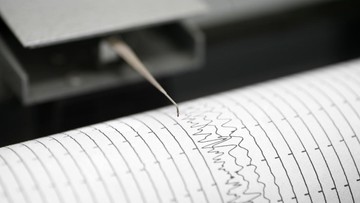Boltim Sulut Guncang! Gempa M 3,9 Menggetarkan Tanah

Mediagaleryjati.biz.id Hai semoga hatimu selalu tenang. Pada Artikel Ini saya ingin berbagi tips dan trik mengenai News. Catatan Artikel Tentang News Boltim Sulut Guncang Gempa M 39 Menggetarkan Tanah simak terus penjelasannya hingga tuntas.
Table of Contents
Understanding Earthquakes
Earthquakes are a natural phenomenon that occur when there is a sudden release of energy in the Earth's crust, leading to seismic waves. This natural disaster can vary in intensity, with some being barely noticeable while others can cause significant damage to infrastructure and pose a threat to lives. Understanding the underlying mechanics of these geological events is crucial for preparedness and response efforts.
The energy release often occurs due to the movement of tectonic plates, which can lead to faults in the Earth's crust. When stress builds up along these faults, it eventually overcomes friction, resulting in an earthquake. The magnitude of the quake is measured using the Richter scale, which quantifies the energy released during the event.
Recent Earthquake Activity in Boltim Sulut
On a recent day, the region of Boltim in North Sulawesi experienced an earthquake with a magnitude of 3.9. Though categorized as a relatively mild quake, it has drawn attention due to its implications for local residents and infrastructure. Seismological agencies monitor such events closely to assess potential risks and offer timely warnings.
The occurrence of earthquakes, even small ones, can ignite concern among local communities. It serves as a reminder of the region's geological activity and the importance of emergency preparedness plans. Residents are encouraged to stay informed about safety protocols and understand how to respond when tremors are felt.
Effects of Earthquakes on Communities
The impact of earthquakes on communities can be profound. Even a minor quake can lead to panic and anxiety among residents, disrupting daily life and causing people to reconsider their safety measures. The physical effects can also include structural damage to buildings, roads, and essential services.
Psychological effects should not be overlooked either. Survivors may experience post-traumatic stress, anxiety, or fear of future quakes. Communities often need to come together to support each other emotionally and physically in the aftermath of seismic events.
Preparedness and Response Strategies
Ensuring communities are prepared for earthquakes is essential for minimizing their impact. Local governments and agencies typically provide educational resources on how to prepare an emergency kit, create a family safety plan, and practice drills. Regular public awareness campaigns can help individuals understand their risks and prepare accordingly.
During an earthquake, knowing how to react can save lives. Recommendations often include “Drop, Cover, and Hold On” to protect oneself from falling debris. Post-quake, swift damage assessments and response strategies are vital for restoring services and ensuring public safety.
The Role of Technology in Monitoring Earthquakes
Advancements in technology have significantly enhanced our ability to monitor seismic activity. Today, seismic networks use a combination of ground-based sensors and satellite technology to detect and analyze earthquakes in real-time. This data helps inform response efforts and improves community preparedness.
Innovative technologies, including artificial intelligence, are being explored to predict earthquakes more accurately. While predictions remain challenging, these advancements hold promise for reducing risks and enhancing safety measures in vulnerable areas.
Building Codes and Infrastructure Resilience
One of the most effective ways to mitigate earthquake damage is through strict building codes. Local governments often enforce regulations that require structures to withstand seismic forces, ensuring safety for occupants. Retrofitting older buildings can also significantly improve their resilience to earthquakes.
Investing in robust infrastructure is vital for community resilience. Cities that prioritize earthquake-resistant designs can minimize destruction and economic loss. This includes not just buildings, but also bridges, roads, and essential services to ensure quick recovery after an earthquake.
Community Awareness and Education
Community awareness initiatives are crucial for improving overall earthquake readiness. Educational programs focused on seismic risks, safety protocols, and emergency response can empower residents to take proactive measures. Schools, local organizations, and government agencies often collaborate to disseminate this information.
Engaging the community in drills and preparedness activities fosters a culture of safety and encourages collective action. The more informed residents are about earthquake hazards, the better equipped they will be to respond effectively when an earthquake occurs.
Case Studies of Recent Earthquake Responses
Examining recent case studies of earthquake responses can provide valuable insights into effective strategies. Various regions that have experienced significant quakes often engage in systematic analyses to identify strengths and weaknesses in their response efforts. Learning from these events helps improve future preparedness.
For instance, communities that implemented proactive measures prior to a seismic event were often more resilient than those that did not. These case studies serve as important reference points for policymakers and residents alike, indicating best practices for handling the aftermath of seismic activity.
Terima kasih telah menyimak boltim sulut guncang gempa m 39 menggetarkan tanah dalam news ini sampai akhir Semoga artikel ini menjadi langkah awal untuk belajar lebih lanjut tetap optimis menghadapi tantangan dan jaga imunitas. Jika kamu suka semoga artikel lainnya juga bermanfaat. Sampai jumpa.
✦ Tanya AI
Saat ini AI kami sedang memiliki traffic tinggi silahkan coba beberapa saat lagi.